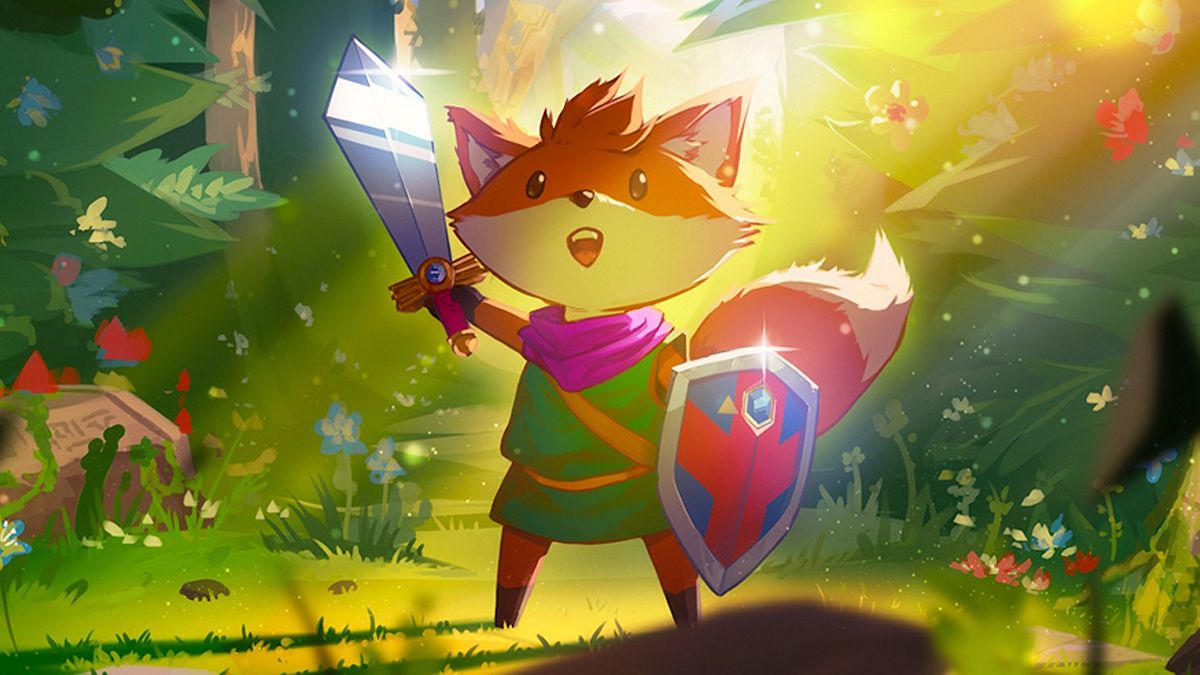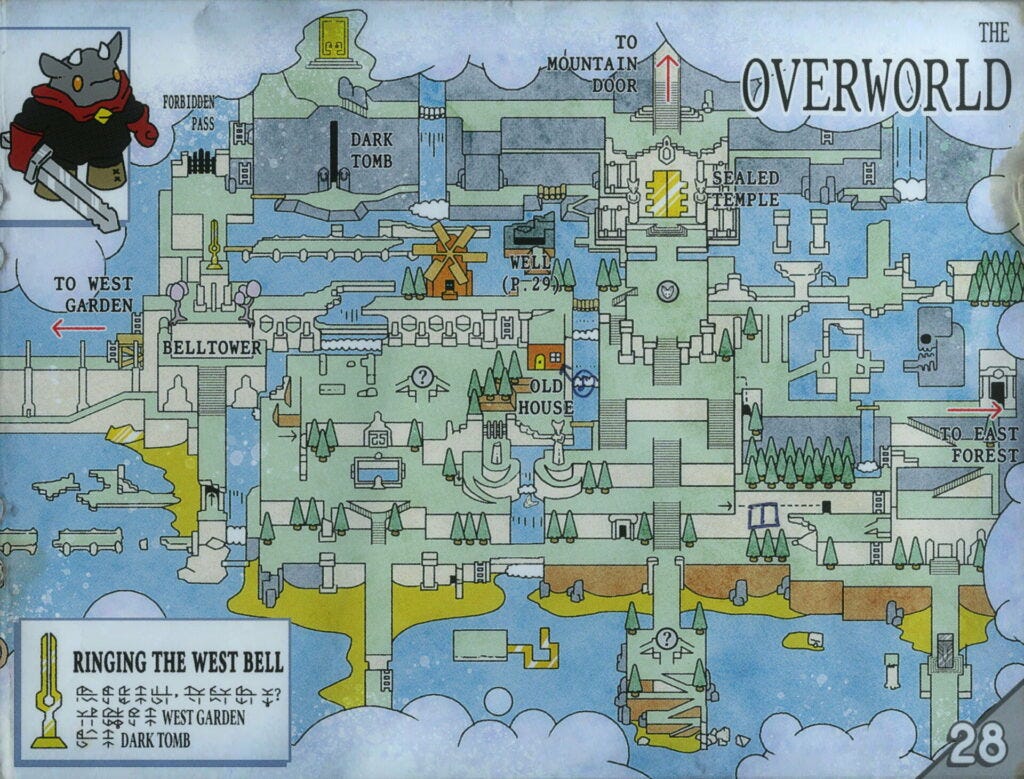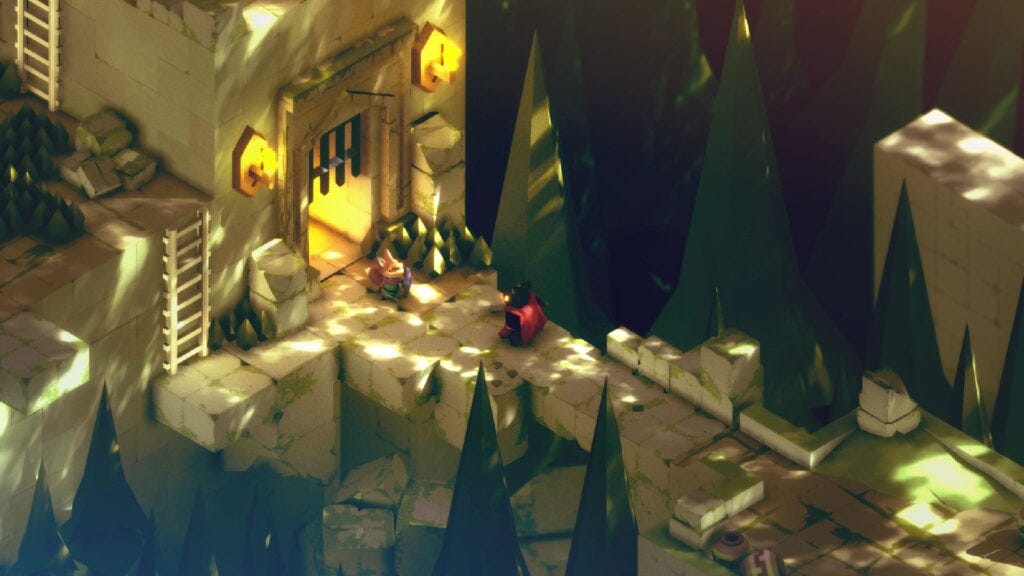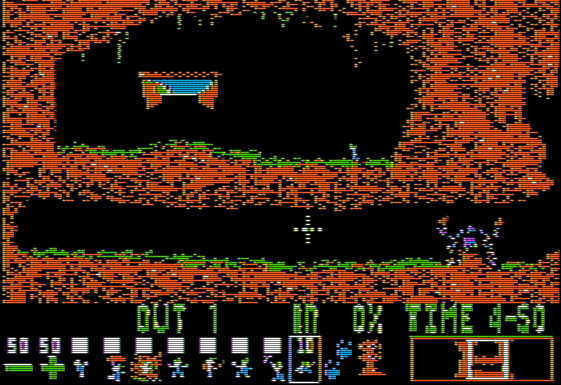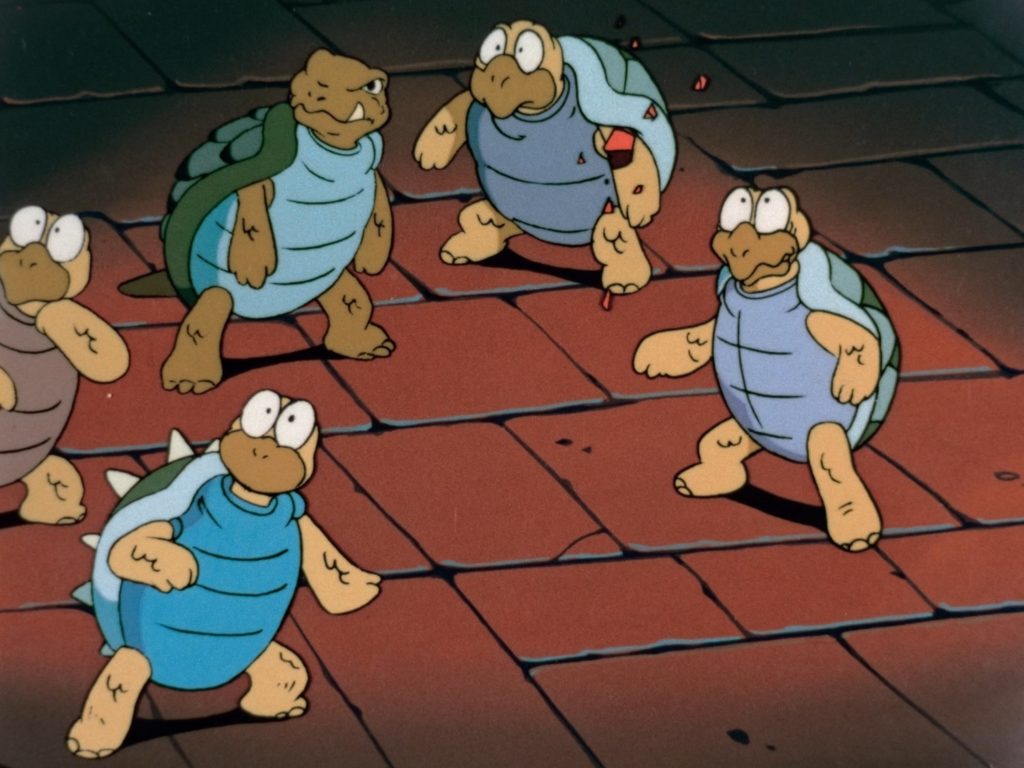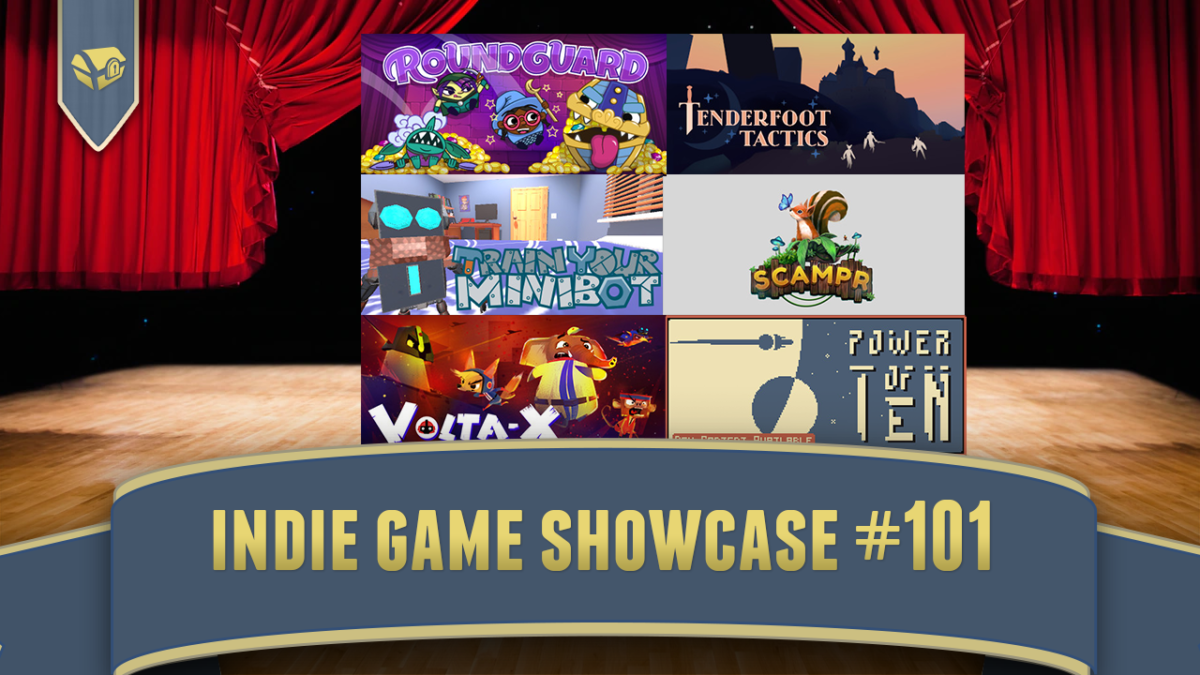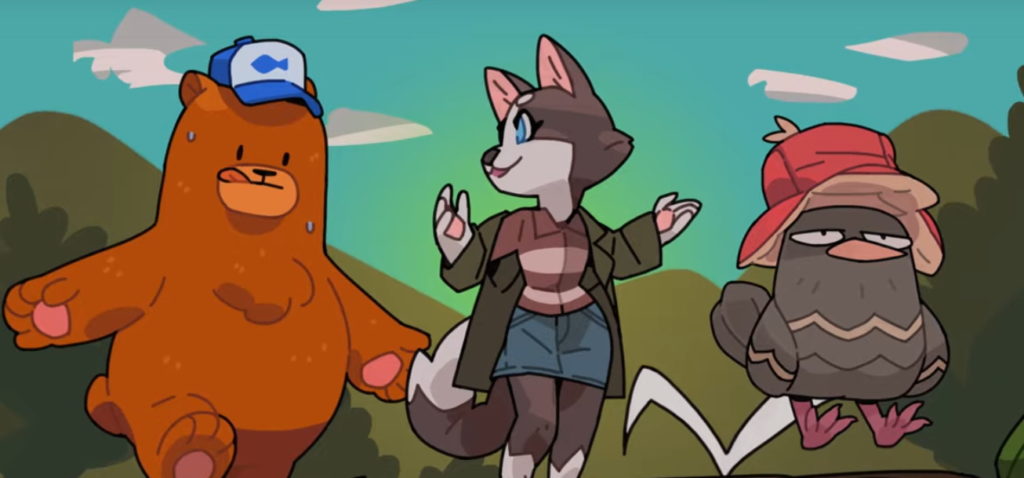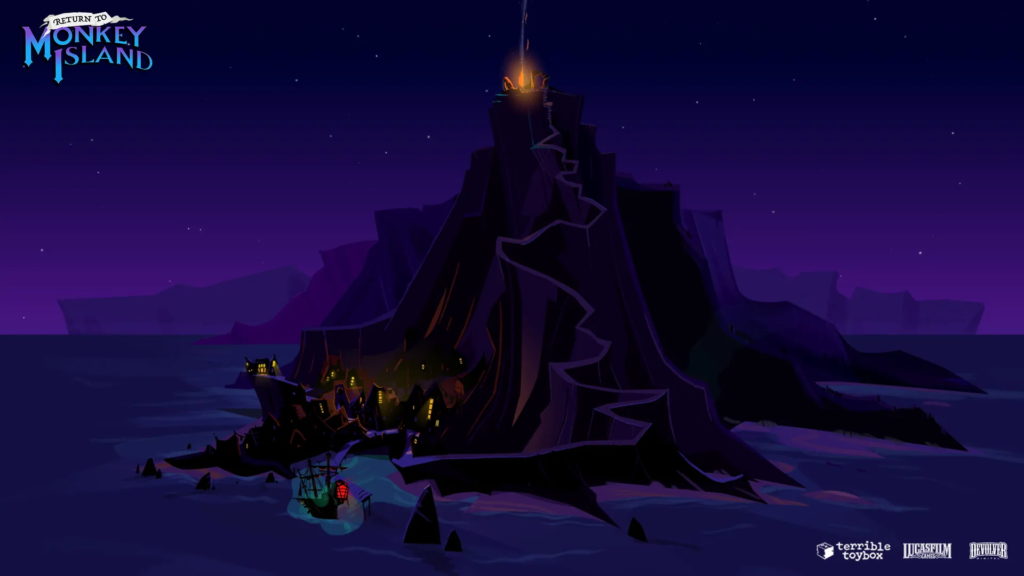
@Play is a continuation of a column on roguelikes that I did back on GameSetWatch. At the moment it is monthly, so please look out for it! GameSetWatch no longer exists on the living web, but it can still be found in the Wayback Machine. (Many of its best articles are also preserved in the book Exploring Roguelike Games, published by CRC Press.)
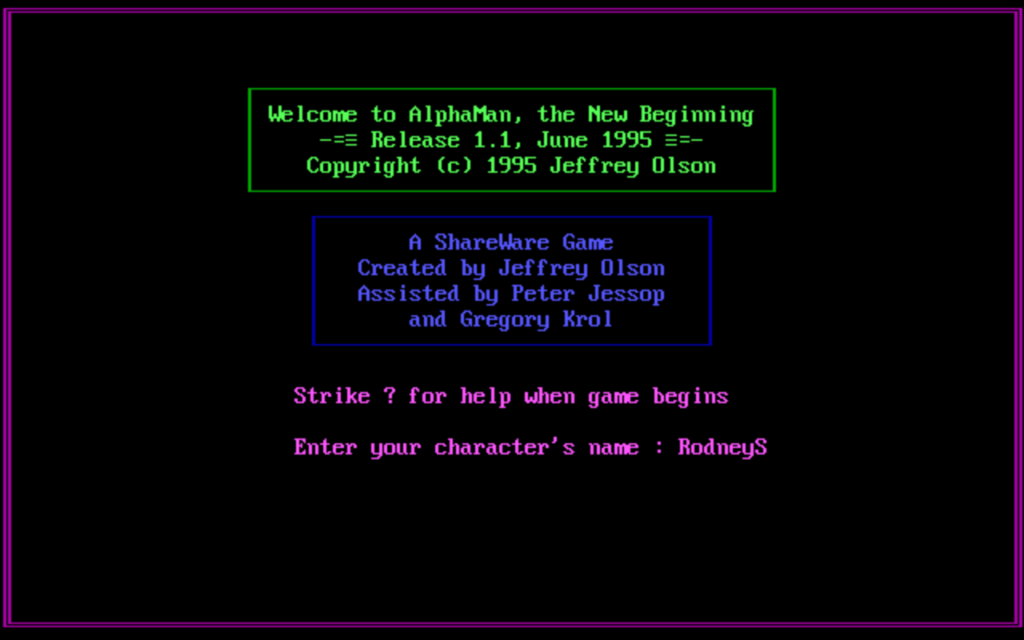
Yeah, I’ve been ekeing a living out of these wastes for years, even since The Bomb ended life as we knew it. Life back then was simple. You might have had a soul-crushing office job, but you didn’t have to face off against vampiric warthogs or psychic blue jays. Just on the way here I was set upon by a stalk of asparagus with a chip on its shoulder and deadly radiation coming out of its leafy head. I had to run up close to it and whack it to death to make it stop zapping me. At least, I think it was dead. It wasn’t moving no more, but the same thing’s the case with normal asparagus. Maybe it’s just resting.
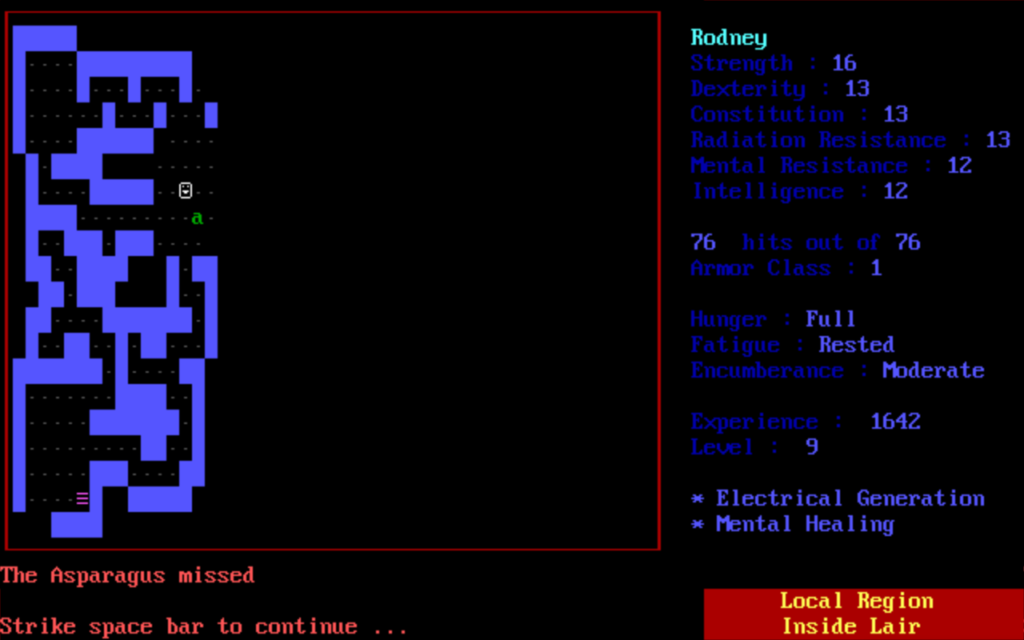
I’m on a mission here from out of state to find the source of a deadly nerve toxin with the power to destroy the rest of life on Earth. First I have to find my informant, Elvis Presley. Yes, that Elvis. The world’s always been a weird place, the nuclear war just made it a whole bunch weirder. But before I can find him, I’ve got to get to his castle. No, not Graceland, the one here in New York. I don’t got time to fill you in on how much you been lied to.
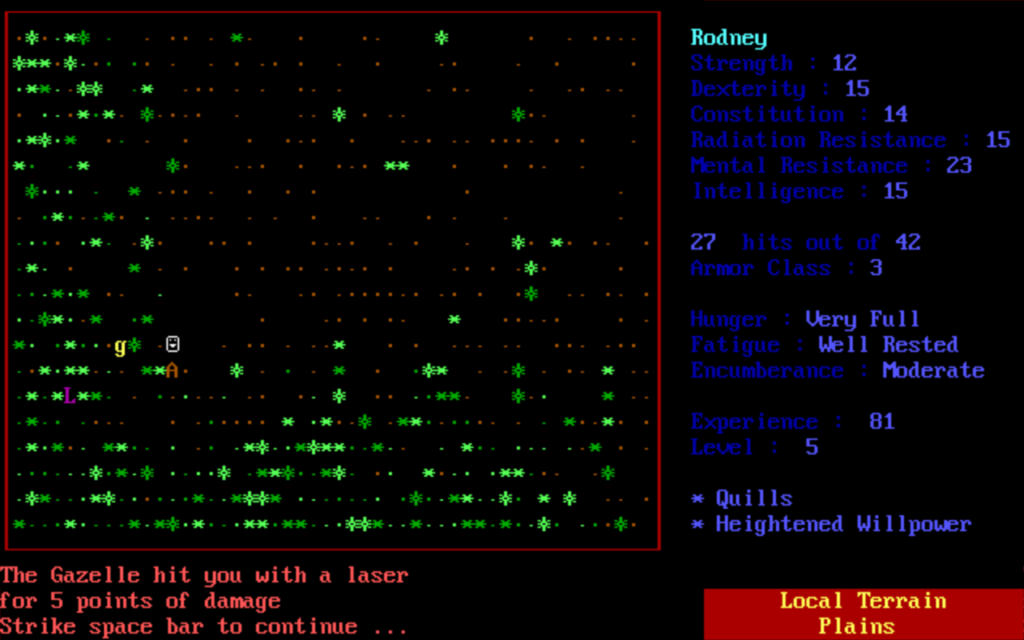
Look over there, it’s a gazelle! Looks harmless, doesn’t it? You see that laser gun on its back? DUCK YOU FOOL, get down behind this rock! Okay, here’s what we do. You run over there to distract it, and I’ll get up close and poke it to death with my pitchfork. We’ve only got once chance at this, we either take down this antisocial ungulate or the whole world, such as it is, is toast. It might suck, but at least we’ve got all these cans of Spam littering the ground to survive off of. You don’t like Spam you say? What do you think this is, a convenience store?
Nuclear weapons have destroyed civilization. You’re a mutated human living in a valley in central New York. This looks like the end.
But maybe it’s not. The world is in bad shape, but life continues, in its way. But maybe not for much longer. An outside group has sent you in as its agent to investigate rumors of some entity that’s obtained a deadly and virulent nerve toxin that could wipe out what remains of life on the planet. You don’t have much information on this being or its location at the outset of your quest. Only that it’s some creature known only as the Grinch….
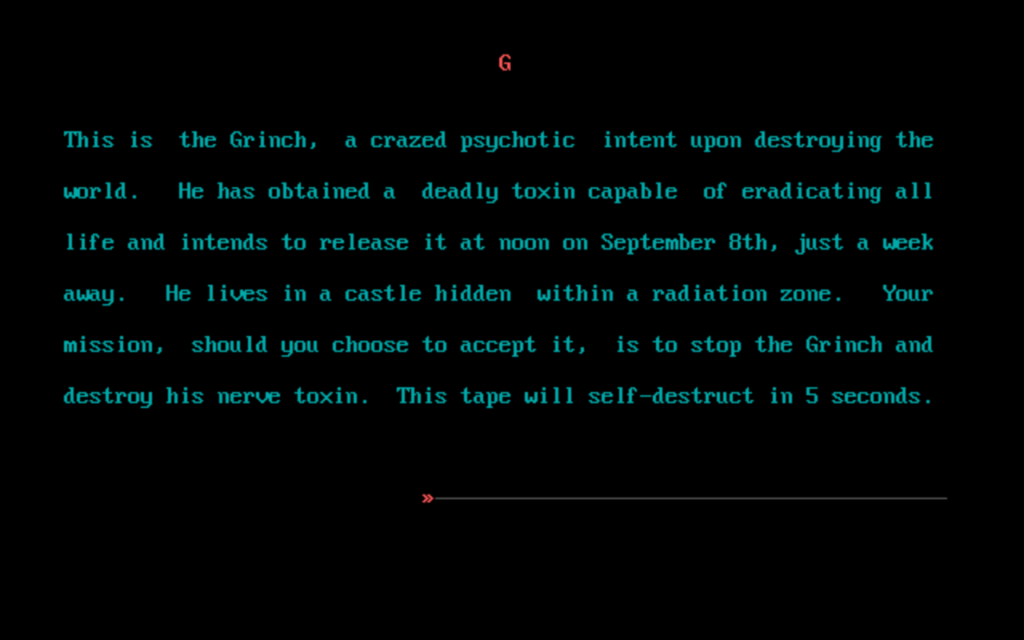
Alphaman Basics
Alphaman is a console-based roguelike computer game released for DOS in 1995. This means it doesn’t qualify as an early roguelike, but it’s still pretty old.
1995 was the year of Windows 95, and at last the beginning of Microsoft’s push to eliminate MS-DOS. DOS wasn’t dead yet though, which was fortuitous for Alphaman, since it’s a DOS console program and can run in Windows 95’s DOS compatibility layer. Nowadays if one doesn’t have access to a PC from that era, they’ll probably have to run it on the emulation platform DOSbox.
It’s been a while since I’ve done an @Play, it might be worth it to go over some really basic basics of both it and classic roguelikes generally.
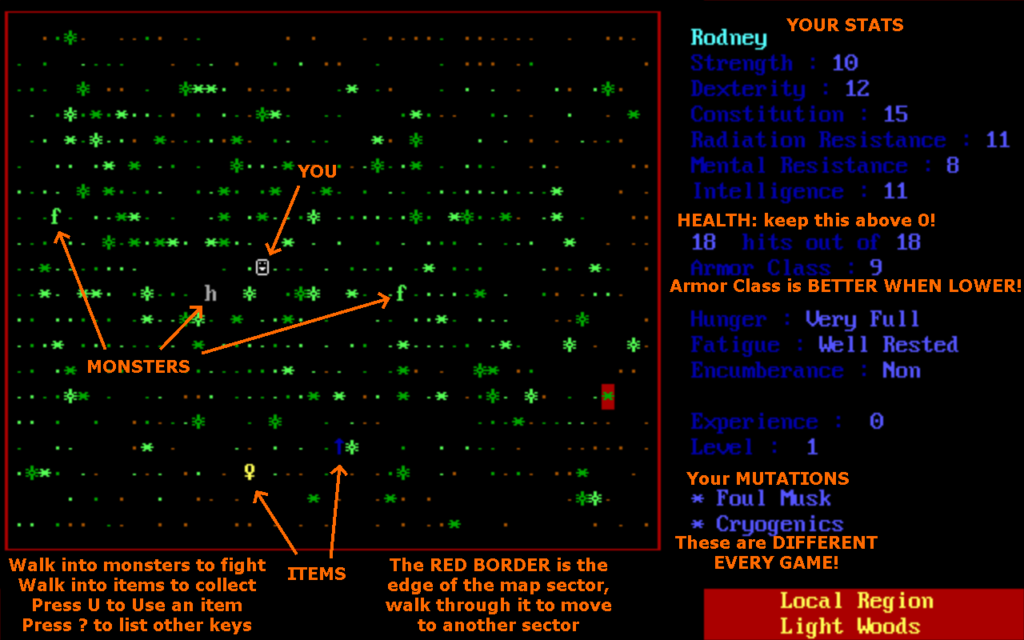
The smiley-face is you. Letters of the alphabet are monsters, most of which are trying to kill you. Walk into a monster to hit it with your currently equipped weapon.
The large green punctuation symbols (not the periods) represent foliage; you usually want to go around these things, but sometimes you might be able to break through.
Other colored punctuation and symbols are usually items you can collect. When you walk on an item, you automatically collect it. This might burden you a lot, if you are carrying many heavy items. When you’re burdened (check the Encumberance status), you tire more easily and get hungry faster.
The red border is the edge of the current section of the world map. Walking into it will give you a brief glimpse of the world around you, then you’ll appear in the next screen over.
You might find a purple symbol in the wilderness. These are lairs. You can go down, into the lair, with the < (Lesser-Than) key. (Note: This is the opposite from other games! In most classic roguelike games, > goes down and < goes up.)
You might find a large blue rectangle with an opening in one side. These are ruins or castles. Walk into the opening to enter and explore. These usually extend both up and down. You can find nice items and tough monsters there. To win the game, you will have to find and explore several castles.
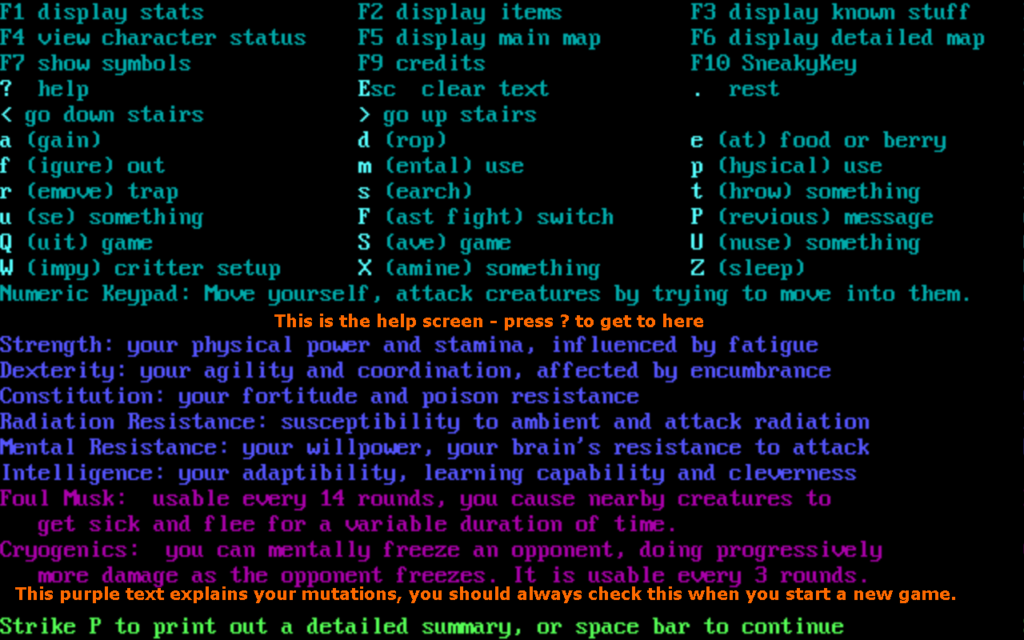
If you press the Question Mark key, you’ll be shown this very helpful screen telling what the various keys do. A capital letter means to hold down Shift while pressing it. Especially note these keys:
- u: Use an item, including wearing armor and wielding weapons
- U: “Unuse” an item, taking armor off and cease wielding a weapon. This also gets items out of a backpack.
- d: Drop an item (use this to become less encumbered)
- f: Try to figure out a device
- e: Eat food (Cans of Spam and Beef-A-Roni, mostly). Also press ‘e’ to eat berries.
- . (period): Rest (to remove fatigue)
- s: Search, checking the eight squares around you for hidden passages, useful in ruins and castles
- p: Use your physical mutation
- m: Use your mental mutation (the u key can also use these)
- t: Throw an item. Use this with darts, shuriken and other missile weapons. You’ll be asked to pick a spot to throw at.
- Z: Sleep. When the sun goes down you must find a quiet place and sleep through the night. Inside a cleared level of a structure or lair is good for this.
- F1-F7: Changes the display to show more information. F2 brings up your inventory, F3 lists items you have identified, F4 shows a summary of your condition, F5 shows the overworld map, and F7 shows a list of symbols relevant to your current location.
As you play, you’ll eventually find better weapons and armor. For armor, Unuse the one you’re currently wearing with Shift-U (items in use are marked with an asterisk in the item list), then use the new one by pressing U. The effectiveness of your current armor is represented by your “Armor Class” in your stats. Armor Class affects how easily monsters can hit you with physical attacks. The game will seem a fair bit easier if you’re wearing good armor.
Alphaman uses the old D&D paradigm for Armor Class, in which lower numbers are better! It starts at 10 and goes down. Negative numbers are especially good! Leather and Hide Armor are weak, Ring and Chain Mail are better, Plate Mail is very good. How are you supposed to know that if you haven’t played a lot of D&D, or aren’t a member of the Society for Creative Anachronism? It’s just one of those little things that all RPG players must absorb, eventually. Some of it you have to figure out as you go. It’s part of the game.
Note, in Alphaman, protective equipment tends to wear out with use. Eventually as you take blows, you’ll be told that your armor is damaged, and then, destroyed. It would be good to have backup armor to put on when that happens.
Up, Down, and Around
As mentioned, Alphaman is set in the future, after a nuclear war that ended civilization, instead of the usual D&D-inspired fantasy scenario. This puts it in the ballpark of D&D’s neglected sister game Gamma World, and its ancestor Metamorphosis Alpha. Instead of magic spells there’s advanced technology and weird mutations, and replacing the monsters from myth and folklore there are deranged versions of animals and plants. Because the setting is on Earth, just in the future, it is less anachronistic to include places, devices and even people from our planet’s history. Alphaman really carries this aspect to extremes with its many pop culture references, as we’ll see later.
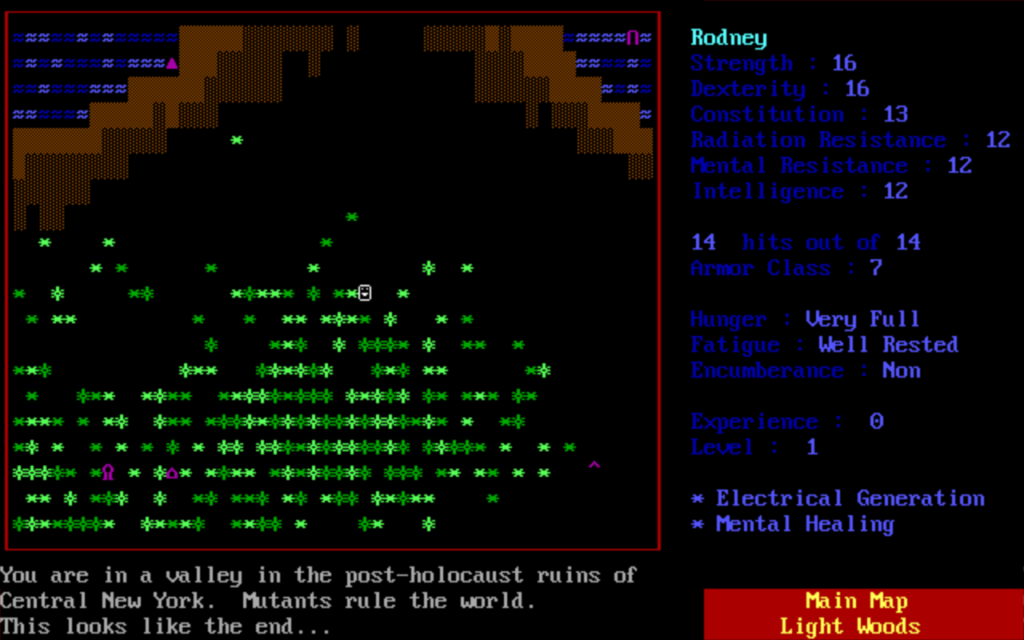
The most popular roguelikes from the time had a “vertical” structure. They were made of a series of single-screen dungeon levels extending deeper and deeper into the earth. Rogue, Hack, NetHack and Larn all do this. ADOM was also like this in its original form, before it got an overworld. Moria and Angband have vertical dungeons, but each dungeon level took up multiple screens, and those games flip between them when the player gets near one of the edges of the viewable area.
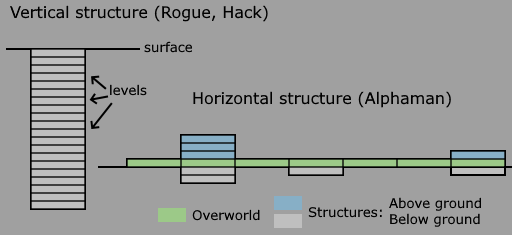
Alphaman has vertical dungeon areas, that extend conceptually either down into the ground, or up into above-ground buildings, or both. But it also has an “overworld”: a wide above-ground region that sprawls out many screens north, south, east, and west. There is both an overworld screen that reveals the large-scale lay of the land, and individual screens contained within it, each representing one square of the overworld. At the start you’re shown the overworld and your location within it, but you’re immediately taken down into your current screen. When your character moves to an edge of that screen, the overworld map and your location are again shown for a moment, then it’s replaced by the map of the new screen your character has entered.
In most roguelikes it is standard practice, in vertical dungeons, that the game stops counting the actions of creatures off of your current level. If you’re adjacent to a monster on the previous level it might be given a chance to follow you, but otherwise it cools its heels while you’re away, assuming you’re not playing one of those games where dungeon levels you leave behind aren’t forgotten about completely.
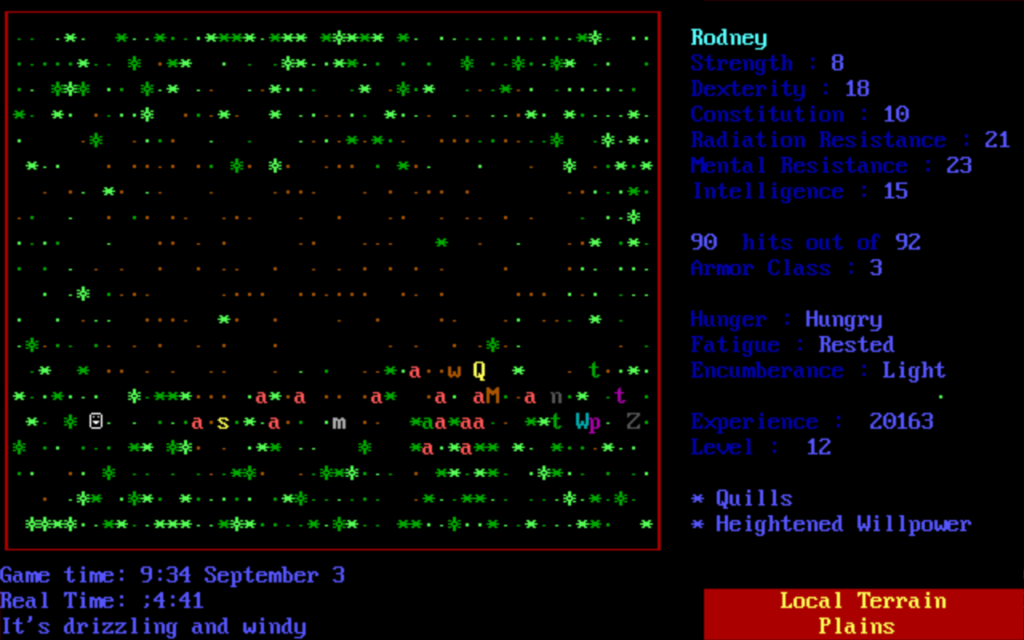
Alphaman works like that when you’re in a location that plays by vertical dungeon rules, but on the overworld, monsters on screens that you leave are not forgotten about. They continue to receive turns, even while they’re out of sight of your character, and can follow you across a substantial portion of the overworld map. It is very likely, as you flee, that the new screens you enter will contain monsters of their own who will happily join in the chase, until you’re leading a whole cloud of angry letters across the leafy landscape of post-apocalyptic New York.
A Funny Thing Happened On The Way To The Apocalypse
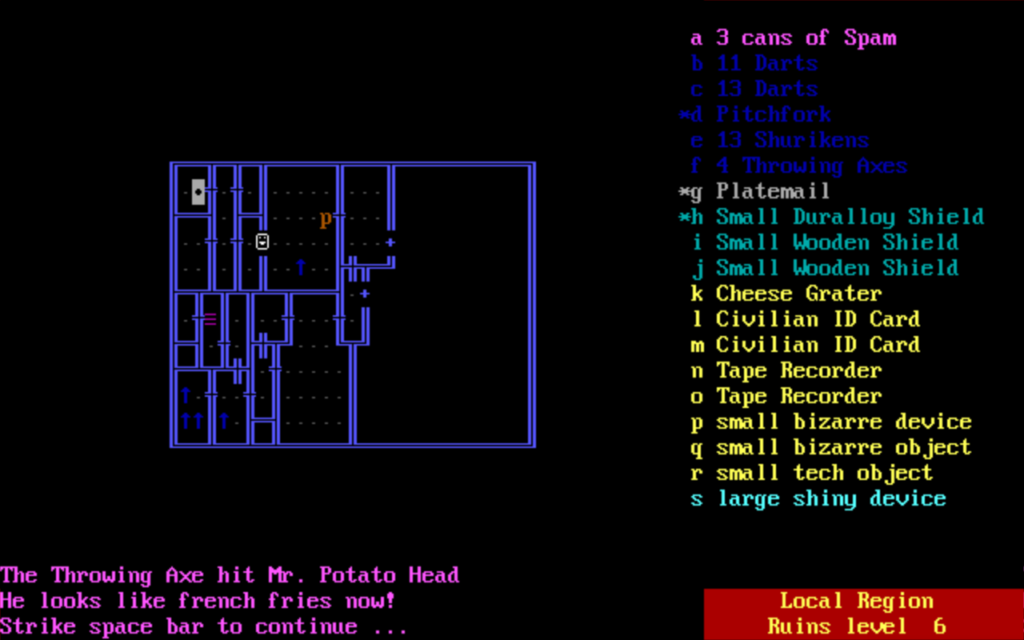
As you might have picked up from the introduction, Alphaman has a lot more pop culture references than the typical roguelike. NetHack, a game that some consider to be excessively burdened by jokes, is reserved compared to Alphaman. In addition to ultimately fighting the Grinch:
- Your first major destination is a castle of Elvis Impersonators where you must find the real one,
- You may visit castles belonging to the Castaways of Gilligan’s Island and the Munsters, and could even end up exploring a Trump casino,
- A lot of miscellaneous monsters may be found throughout the game, like the inhabitants of the castles, as well as: Mr. Potato Head, a “Bush,” who if defeated summons a “Quayle” (this game was published long before the era of Bush 45), an “Algore” that plants grow around, King Kong and Godzilla, “the Blob,” and others.
- A wide variety of wacky devices and objects, some of which are useless, including (just a few) a Chia Pet, a Cheese Grater, and a mask of former Democratic Speaker of the US House of Representatives Tip O’Neill, which blinds you but scares off monsters.
As the Bush/Quayle and Tip O’Neill jokes suggest, the humor of Alphaman is of a distinctly 90’s flavor, and so as time passes the jokes age further and further out of currency. Some people reading this may not even have been alive during the reign of the first George Bush. On the other hand, slaughtering your way through a castle-like Trump Casino carries a special vicarious thrill that people from the 90s probably wouldn’t feel nearly so deeply as today. An important item to collect there is Trump’s “Presidential ID Card.” Did Jeffrey Olson know something then that we didn’t…?
We have so much to tell you about Alphaman, and its creator Jeffrey Olson, that we’re saving more of it for next month. See you then!
Links
The site with the last remaining original mirror of Alphaman is ftp.funet.fi. Alphaman there is alpman11.zip. It can also be found on Abandonia. Alphaman was not the kind of game to get a physical release, and the end screen requests that you distribute it far and wide, so there are no legal issues there.
To play Alphaman now, you’ll need a means of running MS-DOS. You could spin up a virtual machine that runs DOS, but most people will just want to use DOSbox. DOSbox requires a little configuration, but can be used in many different platforms, including Windows, Mac and Linux.
Here is the source code to Alphaman, on GitHub.
Here is The Alphaman FAQ, on Usenet (1995) via Google Groups, which, amazingly, Google hasn’t shut down yet.

